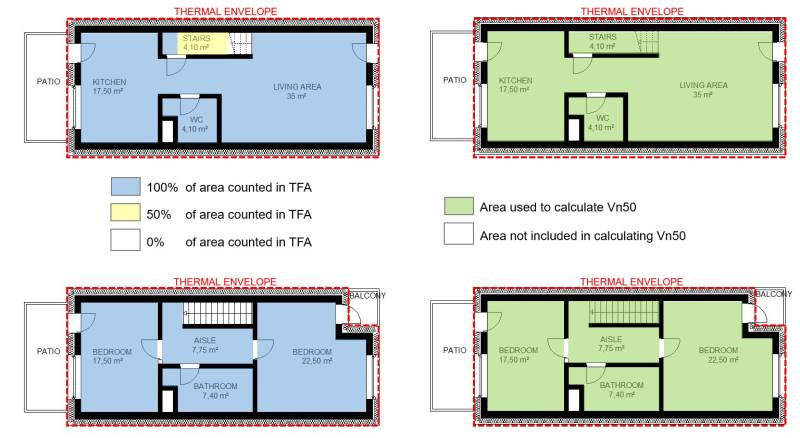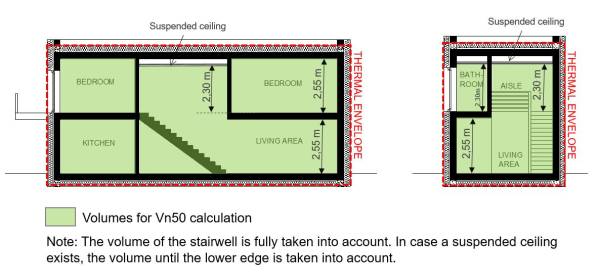Table of Contents
Differentiation between Vv and Vn50 values
The present document is meant to clarify the two different volume measurements required in PHPP calculations, which are listed and briefly defined on the following table:
| Vv | Vn50 |
|---|---|
| Reference volume of the ventilation system | Value of air volume that will be heated or cooled for calculating the n50 leakage value. |
| is used to calculate the air exchange rate | is used for the calculation of n50 |
| Rough calculation: Calculated by multiplying the TFA times an average room height for the entire building. In the case of residential buildings, a standard height of 2.50 m should be considered, regardless of the actual height. | Exact caltulation: All rooms of the building (including the stairs + elevator) are calculated separately by multiplying the net area times the clear room height. |
The next sections provide a detailed description of both values and their calculation.
Vv – Air reference volume of the ventilation system
This value, is calculated by multiplying the treated floor area by the average room height. It is thus rather a reference value than an exact depiction of the volume within the building. For residential buildings on PHPP, it serves to calculate the ventilation heat losses and is only relevant to determine the minimal air change rate of 0.3 1/h, independent of occupation, necessary to ensure an appropriate air quality. For non-residential buildings, the value is merely informative for the calculation of the air exchange rate and does not really influence the calculation of ventilation heat losses.
The air volume Vv, is the energy reference area (Treated Floor Area, ATFA) multiplied by the room height. A standard residential room height of 2.5 m is used for simplification purposes. This is a fixed value since the amount of emissions unrelated to occupants depend on the living space and hardly increase with larger room height. Therefore, for greater room heights in residential buildings it is recommended to not enter a larger value, since this would tend to result in an excessive exchanged air volume and an indoor humidity level during the winter that may be too low. For non-residential buildings, the mean value of all room heights should be entered here.
The air volume Vv is calculated automatically by PHPP based on the TFA calculation by the user and the entered room height.
For further reference, please see the current PHPP manual (PHPP 9 manual: section 21.2.9).
Vn50 – Net air volume for pressurisation test
The air volume Vn50 within the heated building envelope is the volume that will be used for calculating the n50 air leakage value. It is supposed to indicate the actual volume of air that will be heated or cooled within the building and should be calculated separately for each room. The calculation must be carried out in accordance with detailed rules given in the Criteria for Buildings, section 3.2.10 Airtightness of the building envelope.
Example
Single family house - Calculation of TFA, VV and Vn50
 |
|
| The area counted in TFA is highlighted blue and yellow. | The area to be considered for the Vn50 calculation is highlighted green. |
 |
| Sections of example calculation project: The area to be considered for the Vn50 calculation is highlighted green. |
A more detailed explanation can be found in the following sources:


